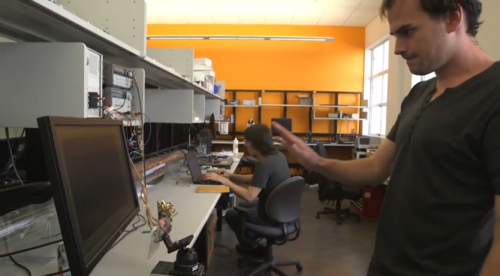November 1, 2013 report
Spinoff to introduce ultrasonic gesture recognition for small devices (w/ Video)

(Phys.org) —A group of research engineers at the University of California has been working on new technology to allow electronic devices to recognize hand gestures, similar to Microsoft's Kinect—with a major difference. Instead of using light, the new technology is based on sound waves. The group is currently forming a spinoff company to develop and market the technology, called Chirp Microsystems (the technology itself is called simply Chirp).
Recognizing that devices are getting smaller, including their screens, of course, the researchers began looking into ways users might be able to use gesture recognition, instead of physically touching a device to give it commands (waving a hand in the air above it, rather than swipping the screen, for example). They found that using light as a medium required bulky equipment and would only work in optimal situations. That caused them to turn to studying sound as a means of sending information instead. That in turn led to the development of two computer chips, one is an ultrasound chip, the other is a chip that sends and receives electrical signals from the ultrasound chip. A third component is a battery. The system works by generating sound wave pulses using a very tiny array of sound transducers (speakers). The chip then listens to the pulses when they are bounced back. Doing so allows the chip to calculate how far away something is, just like radar. Even better, the new technology uses just a fraction of the power of light based systems, and it's small enough to be embedded in even the smallest devices, such as smartwatches.
Gesture recognition technology would be ideally suited to both smartwatches and headsets, allowing for new types of movement to be incorporated into a command set. Simply drawing the wrist towards the face, could for example, activate a smartwatch. Also, wiping the air in front of a headset, such as Google's could allow for swiping virtual objects. That might be good news for both devices, as thus far, consumers haven't been very receptive to either. Making them less awkward to use, could mark a turning point, causing the development of all manner of tiny niche devices such as smartnecklaces, fobs or even tiny smartscreens embedded in contact lenses.
© 2013 Phys.org





















